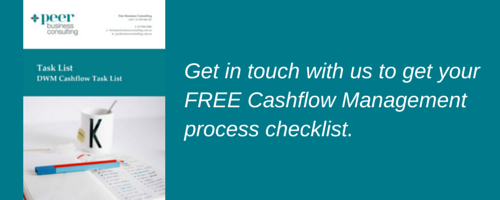A couple of weeks ago, I had the pleasure of presenting another workshop at The Lounge presented by Modewest Magazine. And this time we talked about – you name it – CASH! Well actually we talked about cashflows… and budgets… and how to manage our everyday money as business owners. Another excellent day with great participation and engagement by all, especially given the confronting nature of the topic!
You won’t be surprised to read that cashflow management is a major struggle for many business owners and one of the top three reasons why 74% of small businesses fail within their first five years. So, in the interests of “sharing and caring” (as my old boss used to say!), here are my 28 ways to smooth out your cashflows and manage your everyday money.
Let’s break it down into ways to smoothing out your inflows (that’s money coming in) and outflows (that’s money going out) and then a whole bunch of general money management tips. Enjoy!
8 tactics for more predictable inflows
- Aim for consistent inflows each month (ideally increasing from month to month).
- Diversify your income, i.e. don’t put all your eggs into one basket. For tips on how to do that, read my article When it comes to income… diversify, diversify, diversify.
- Always keep a healthy sales pipeline – don’t neglect lead generation and lead nurturing activities when you’re busy. That means, don’t stop networking and keep in touch with your VIP clients and serious prospects during your busy times.
- Use a CRM system to keep track of your sales pipeline. Without a system, you’re just guessing. Make it easy on yourself and use one of the many tools out there, e.g. Capsule CRM, Zoho, Sugar CRM, Insightly, etc.
- Get paid upfront (if possible), or at least ask for a 50% deposit. This is standard for businesses selling products, but it’s easy if you’re a service-based business too. Just have clear Terms and Conditions to which the client must agree before you start working with them.
- Implement non-refundable deposits & late payment fees to reduce the chance of project cancellations or refunds, and to encourage clients to pay on time.
- Prevent loss of income by having clear project cancellation terms and conditions, e.g. if the deposit is not paid within a month, then the project is deemed cancelled.
- Prevent time wastage – don’t start work until you have everything you need from the client.
“…cashflow management is a major struggle for many business owners and one of the top three reasons why 74% of small businesses fail within their first five years.”
7 tactics for smoothing outflows
- Create a budget for all your expenses (even occasional expenses) – and stick to it!
- Track everything you spend. There are plenty of good budgeting and expense tracking apps and software such as Xero, YNAB and MYOB that make this easy.
- Analyse your spending against your budget regularly. I do it at the end of each month. This will help you understand where most of your money is going and help you see clear opportunities for saving.
- Don’t be afraid of the truth – you can’t fix what you don’t know about and the only way you will know is to do 1, 2 and 3 above!
- Be ruthless and stop superfluous spending. No judgments here but you might not need that 10th pair of stilettos! 😉
- Increase the frequency of regular expenses. It is generally much better to pay less more often. For example, insurance premiums, utilities and council rates can easily be converted to monthly direct debit payments. The key here is to align frequency of outgoings with the frequency of your incomings. So if you’re only paid every quarter, a monthly frequency for your expenses might not be appropriate.
- Create provision accounts (separate from your main bank account) for tax. Tax has to be paid. Full stop. That includes GST (if you’re registered), income tax and payroll tax (if you have staff). Don’t mess around. Trust me! Set up a provision account and physically move a % of your income (ask your tax accountant what is best for your business) into your provision account. Do this every month, or more regularly if you think you’ll spend it during the month. Out of mind out of sight. Then when you have to pay your tax bill, you’re not scrounging around trying to raise the funds.
Even more ways to manage your money
- Have a buffer/backup capital in case of lean times. And there will be lean times. Let’s call it your emergency fund.
- If you don’t have that, put every spare cent into creating/adding to your buffer/emergency fund. Even $10 per week adds up over time and could end up paying for a new fridge when you need it.
- Treat tax, staff payroll and your suppliers as your top priorities for payment – you can usually negotiate payments to others but it’s not a good idea to upset the government or the people who will most help you deliver your product/service to your customers.
- Don’t worry about paying all your bills on time all the time. Obviously, take this with a grain of salt. You don’t want to have debt collectors beating down your door. All I mean by this is that you should ensure that the highest priority people are paid first and if that means you need to be a bit late with another bill, then it’s a simple phone call to negotiate a payment plan or ask for an extension.
- Don’t get ahead of yourself – build a nest egg before going on that shopping spree. I hear about this a lot. Business owners who made their first $1000 and then spent it all, leaving them nothing. Focus on building a little bit of wealth before you call yourself a rich person and start spending like one!
- Operate as lean as you can – put spare money back into the business. This is mostly true in the beginning of your business life. Over time, you can relax with this a little.
- Don’t forget about profit (income minus expenses). Keep an eye on what your profit is doing. Even if you earning a consistent income and are paying all your bills, your profit may be low or zero. Expected profit margins differ between industries and types of businesses.
- Review your profitability, i.e. the time and materials cost to create your product/service vs income earned.
- Be scrupulous with how you spend your time – focus most of your time on income generating activities and delegate or outsource anything else.
- Assess the cashflow status of your clients – cull those who won’t pay upfront or don’t pay on time.
- Don’t be an ostrich – be brave, proactive and diligent with your cashflow management.
- Put the work in to understand your own finances – don’t delegate understanding and insight. By all means, delegate the bookkeeping and tax accounting, etc. but make sure you understand where your money is coming and going, and the things to do to improve your cashflows, if required.
- Establish a cashflow management process.
I hope you found my 28 tips for managing your everyday money useful. Do you have any more tips to share? Let me know in the comments. Happy cashflow management!
* Image sourced from Death to the Stock Photo and logo used with permission from The Lounge.
—
 What did you think of this article? Post your comments and questions below. And if you found this useful, please share with your networks.
What did you think of this article? Post your comments and questions below. And if you found this useful, please share with your networks.
About the Author: Angeline Zaghloul is an expert in business strategy, client management and business processes, and is the Principal of Peer Business Consulting, a Sydney-based consultancy providing strategy and operations support to startups and small businesses.
* Portrait by Markus Jaaskelainen.



Half of the businesses that started operating in aust in 2010-11 were still operating in June 2014 according to latest abs figures
Hi Paul, thanks for that. I haven’t seen the latest stats – do you have a link you can refer us to? I’d love to review them.